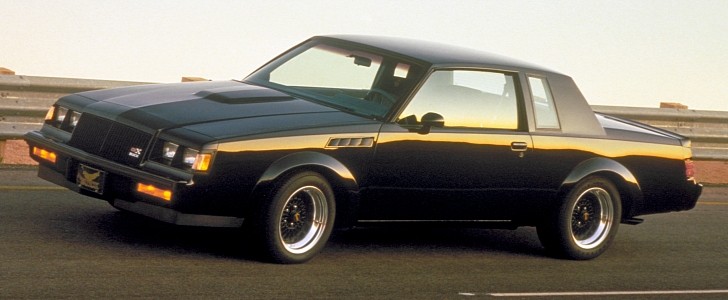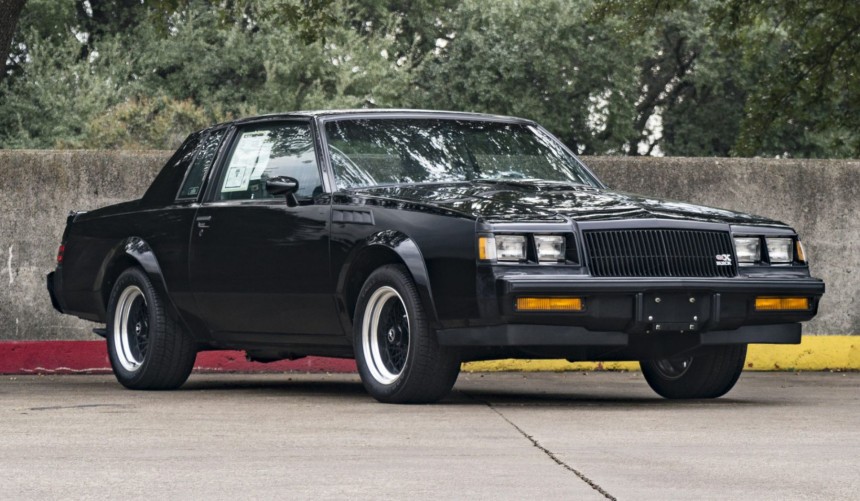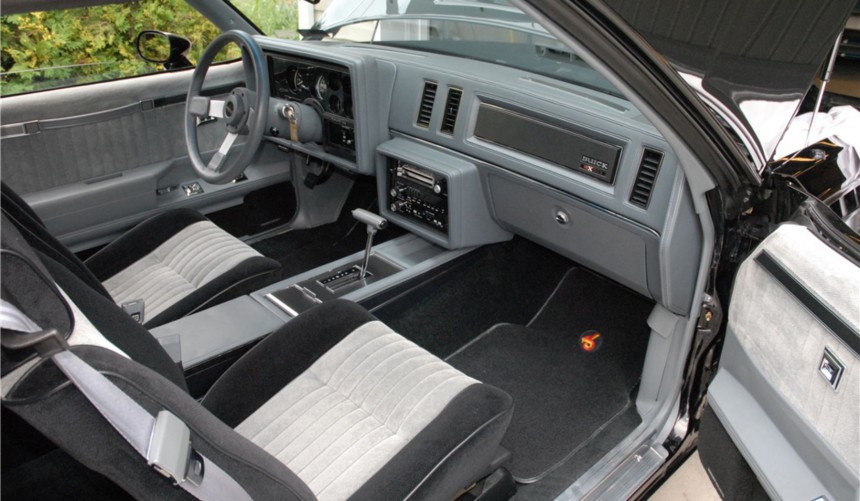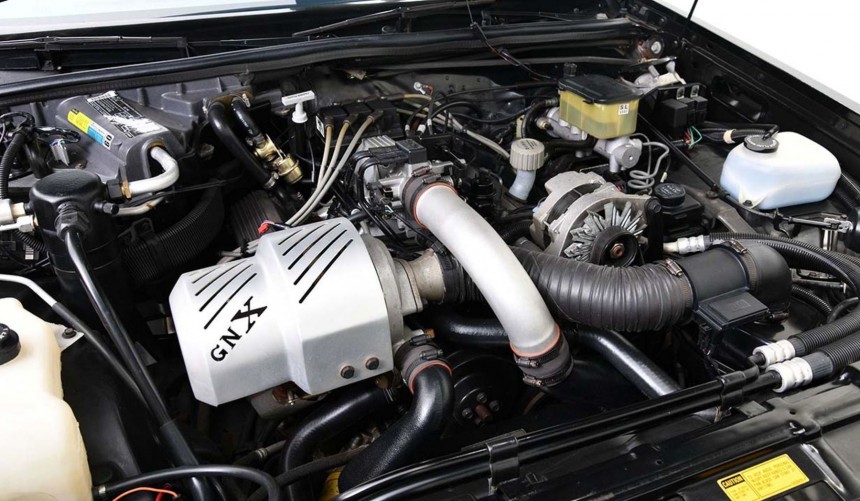Nowadays, if you want to torture someone who loves cars, you can take him to a Buick dealership. With an all-crossover lineup that offers everything but excitement or innovation, the brand is a shadow of its former self. However, the atmosphere was completely different in 1987, when those dealerships were home to the GNX, the coolest model to ever don Buick badges.
In the early 1980s, Buick was a brand favored by lawyers, doctors, and retirees who were looking for a comfortable and luxurious car rather than a performance-oriented, tire-shredding beast. Because of this, the company’s dealerships rarely saw any visitors, much like what’s happening today.
But, back then, GM wasn’t content with the situation and decided it was time for a radical change of image for the struggling brand. The tried-and-true solution they chose to lure in younger buyers was to bring back the muscle into the Buick lineup and pump more funds into their NASCAR program. This move led to factory-backed Regals securing two consecutive championships in 1981 and 1982 as well as the birth of the 1982 Grand National (GN) - a performance-oriented, limited-edition Regal coupe named after NASCAR’s premier series – which provided a sales boost that exceeded even the most optimistic estimates.
Much to everyone’s disappointment, the Grand National didn’t return for 1983 but Buick listened to their fanbase and brought it back a year later with a much more capable turbocharged V6. The model continued to be successfully marketed throughout 1987, the final year of production for the second-generation Regal.
To properly bid farewell to this game-changing model, the company announced the introduction of the Grand National Experimental (GNX) in 1987. This was another limited edition but, unlike the previous versions, it was conceived as the ultimate, most rabid GN of them all.
The idea for this four-wheeled bundle of insanity came from Buick’s chief engineer, Dave Sharpe who petitioned the top brass to greenlight the creation of the quickest GM production four-seater. The standard model was doing so well in terms of sales that the approval for the project came without any hesitation, so Sharpe and his team got to work immediately, enlisting McLaren Performance Technologies/ASC to help with development and assembly.
To the untrained eye, the stealthy all-black GNX looked nearly identical to its siblings. The exterior only gained bulkier fender flares, 16-inch Pontiac Trans Am-inspired wheels, functional vents on the front fenders, and a couple of GNX badges. Inside, a set of analog Stewart-Warner gauges coupled with additional GNX badges were the only features that differentiated this model from the ordinary GNs.
The multitude of upgrades was hidden from plain sight. For starters, the rear suspension was completely overhauled. The system now employed a Panhard bar setup on the upgraded differential to maximize grip. Furthermore, the Goodyear Eagle Gatorback VR50 tires were wider and better suited for the powerful car.
The GNX received the same 231-ci (3.8-liter) 245-hp turbocharged V6 of the standard GN but the powerplant was also extensively improved to maximize performance. The most dramatic upgrade was a bespoke Garrett T3 turbo fitted with a ceramic impeller that blew through a more efficient intercooler with a ceramic-coated shield and inlet pipe. The engine’s ECU was enhanced to allow up to 15 psi (1.03 bar) of boost and to top it all off with an unmistakable sound, a custom, large-diameter dual exhaust system was added. Even the four-speed THM200-4R transmission was recalibrated and received a new performance torque converter along with a larger cooler to enable shorter shifts and boost acceleration.
These modifications translated to an output of 276 hp (206 kW) at 4,400 rpm and a massive 360 lb-ft (488 Nm) of torque available as low as 3,000 rpm. The story goes that Buick deliberately understated these figures as the car was, in fact, capable of 300 hp (224 kW) and 420 lb-ft (569 Nm) of torque when it was put on a dyno.
While the actual output figures are debatable, there was no room for doubt when it comes to straight-line performance. The GNX was a monster that could accelerate from 0 to 60 mph (0-97 kph) in 5.5 seconds and complete the quarter-mile (402 m) in 13.4 seconds at 100 mph (161 kph). To put it into perspective, a 1987 Ferrari Testarossa which was much lighter and powerful could sprint from 0 to 60 mph in 5.2 seconds, but the quarter-mile time was a tenth of a second slower.
These mind-blowing numbers made the GNX an instant hit. Buick initially planned to offer just 200 units, but due to the high demand, 547 were eventually built in 1987, each with a sticker price that exceeded $29,000 ($68,360 today).
These days, a low-milage example in excellent shape goes for more than $250,000. It has become a prized collector’s item and one of the most sought-after vehicles built during the 1980s.
Normally, an American coupe with a turbocharged six-cylinder isn’t considered a true muscle car, yet the GNX doesn’t just make the cut, but deservingly earns its place among the most iconic muscle cars ever built.
You can hear it roar and see it driving down the street in the 2019 episode of Jay Leno’s Garage posted below.
But, back then, GM wasn’t content with the situation and decided it was time for a radical change of image for the struggling brand. The tried-and-true solution they chose to lure in younger buyers was to bring back the muscle into the Buick lineup and pump more funds into their NASCAR program. This move led to factory-backed Regals securing two consecutive championships in 1981 and 1982 as well as the birth of the 1982 Grand National (GN) - a performance-oriented, limited-edition Regal coupe named after NASCAR’s premier series – which provided a sales boost that exceeded even the most optimistic estimates.
Much to everyone’s disappointment, the Grand National didn’t return for 1983 but Buick listened to their fanbase and brought it back a year later with a much more capable turbocharged V6. The model continued to be successfully marketed throughout 1987, the final year of production for the second-generation Regal.
The idea for this four-wheeled bundle of insanity came from Buick’s chief engineer, Dave Sharpe who petitioned the top brass to greenlight the creation of the quickest GM production four-seater. The standard model was doing so well in terms of sales that the approval for the project came without any hesitation, so Sharpe and his team got to work immediately, enlisting McLaren Performance Technologies/ASC to help with development and assembly.
To the untrained eye, the stealthy all-black GNX looked nearly identical to its siblings. The exterior only gained bulkier fender flares, 16-inch Pontiac Trans Am-inspired wheels, functional vents on the front fenders, and a couple of GNX badges. Inside, a set of analog Stewart-Warner gauges coupled with additional GNX badges were the only features that differentiated this model from the ordinary GNs.
The GNX received the same 231-ci (3.8-liter) 245-hp turbocharged V6 of the standard GN but the powerplant was also extensively improved to maximize performance. The most dramatic upgrade was a bespoke Garrett T3 turbo fitted with a ceramic impeller that blew through a more efficient intercooler with a ceramic-coated shield and inlet pipe. The engine’s ECU was enhanced to allow up to 15 psi (1.03 bar) of boost and to top it all off with an unmistakable sound, a custom, large-diameter dual exhaust system was added. Even the four-speed THM200-4R transmission was recalibrated and received a new performance torque converter along with a larger cooler to enable shorter shifts and boost acceleration.
These modifications translated to an output of 276 hp (206 kW) at 4,400 rpm and a massive 360 lb-ft (488 Nm) of torque available as low as 3,000 rpm. The story goes that Buick deliberately understated these figures as the car was, in fact, capable of 300 hp (224 kW) and 420 lb-ft (569 Nm) of torque when it was put on a dyno.
These mind-blowing numbers made the GNX an instant hit. Buick initially planned to offer just 200 units, but due to the high demand, 547 were eventually built in 1987, each with a sticker price that exceeded $29,000 ($68,360 today).
These days, a low-milage example in excellent shape goes for more than $250,000. It has become a prized collector’s item and one of the most sought-after vehicles built during the 1980s.
Normally, an American coupe with a turbocharged six-cylinder isn’t considered a true muscle car, yet the GNX doesn’t just make the cut, but deservingly earns its place among the most iconic muscle cars ever built.
You can hear it roar and see it driving down the street in the 2019 episode of Jay Leno’s Garage posted below.














